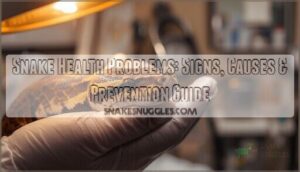This site is supported by our readers. We may earn a commission, at no cost to you, if you purchase through links.
 Your snake’s health depends on recognizing early warning signs before they become serious problems.
Your snake’s health depends on recognizing early warning signs before they become serious problems.
Pet snake health issues like respiratory infections show up as wheezing, mouth breathing, or nasal discharge. Watch for lethargy, appetite loss, unusual hiding behavior, and changes in shedding patterns.
Skin problems appear as retained shed, mites, or discolored patches. Mouth rot creates swelling and discharge around the mouth area.
Temperature and humidity imbalances often trigger these conditions, making proper environmental control essential. Most issues respond well to veterinary treatment when caught early, but delayed care can turn manageable problems into life-threatening emergencies that require intensive intervention.
Table Of Contents
- Key Takeaways
- Common Snake Health Issues
- Signs of Illness in Snakes
- Snake Respiratory Problems
- Environmental Health Factors
- Treating Snake Health Issues
- Frequently Asked Questions (FAQs)
- What are the most common health problems seen in pet snakes?
- What are the signs of illness in snakes?
- Do snakes have respiratory problems?
- Are snakes prone to health problems?
- What is pet snake health?
- Do snakes need veterinary care?
- How often should I take my snake to the vet?
- Can snakes get stressed and how to reduce it?
- What vaccines or preventive medications do snakes need?
- How do I safely handle a sick snake?
- Conclusion
Key Takeaways
- Watch for subtle warning signs – You’ll need to observe breathing patterns, appetite changes, shedding problems, and behavioral shifts since snakes naturally hide illness until it’s serious.
- Control your snake’s environment precisely – You must maintain proper temperature gradients (75-88°F), humidity levels (70-80%), and cleanliness to prevent most health issues from developing.
- Get veterinary care immediately when you notice symptoms – Respiratory infections, parasites, and skin conditions can become life-threatening quickly without proper antibiotic or antifungal treatment.
- Focus on prevention through proper husbandry – You’ll save money and stress by maintaining clean substrates, adequate hiding spots, proper feeding schedules, and quarantining new snakes for 30 days.
Common Snake Health Issues
Your snake’s health can deteriorate quickly without obvious warning signs, making early detection essential for successful treatment.
Understanding common health issues like respiratory infections, skin disorders, and parasitic infestations helps you recognize problems before they become life-threatening emergencies.
Respiratory Infections
Why do snakes wheeze like tiny dragons? Respiratory infections strike when temperatures drop below 75°F or humidity soars unchecked.
You’ll notice wheezing causes distress, nasal discharge, and open-mouth breathing. Bacterial pneumonia dominates, though fungal infections exploit weakened immunity.
Breathlessness treatment requires antibiotics like enrofloxacin, plus supportive heat therapy. These respiratory problems demand immediate veterinary attention.
Snakes require proper reptile care guidelines to prevent such infections.
Skin Disorders
Dermatitis strikes without warning, turning your snake’s pristine scales into a battlefield of infection.
Poor humidity levels create the perfect storm for bacterial growth, leading to painful blisters and raw patches.
- Scale rot eats away at belly scales like rust on metal
- Skin lesions appear as dark, angry spots demanding immediate attention
- Blistering creates fluid-filled pockets that burst and weep
- Shedding issues leave retained skin clinging stubbornly to your pet
- Skin infections spread rapidly, threatening your snake’s entire system
Parasitic Infections
Parasitic infections pose a real threat to your snake’s health, with both internal and external varieties causing serious complications.
Most pet snakes contract parasitic infections from contaminated prey or new tankmates, making prevention challenging but not impossible.
| Parasite Type | Common Examples | Key Symptoms |
|---|---|---|
| External | Snake Mites, Ticks | Visible crawling specks, anemia, restlessness |
| Internal | Roundworms, Coccidia, Hookworms | Weight loss, regurgitation, diarrhea |
| Protozoan | Cryptosporidium, Giardia | Digestive issues, mid-body swelling, lethargy |
Mite infestations appear as tiny moving dots on your snake’s skin, while tick diseases can transmit bacteria.
Worm infections often show no symptoms until advanced stages.
Protozoan parasites attack the digestive system, causing chronic problems.
Wild-caught snakes carry parasites and need immediate veterinary screening.
Antiparasitic medication requires professional diagnosis – don’t guess at treatment.
Metabolic Bone Disease
Calcium deficiency threatens your snake’s skeletal system, causing metabolic bone disease that weakens bones and creates deformities.
Without proper UVB lighting and dietary needs met through mineral supplements, your pet faces serious health risks. Understanding the role of ketosis and metabolism is essential for maintaining healthy health in snakes.
- Bone deformity – Spinal kinks and jaw malformations develop from inadequate calcium absorption
- UVB exposure deficits – Insufficient lighting prevents vitamin D3 synthesis needed for calcium metabolism
- Temperature gradients – Improper heating disrupts nutrient processing and bone development
- Nutritional deficiencies – Poor prey quality or feeding schedules compromise mineral intake requirements
Nutritional Deficiencies
Inadequate nutrition slowly weakens your snake’s immune system and disrupts normal growth patterns.
Vitamin Deficit and Mineral Imbalance create cascading health problems, while Feeding Errors lead to obvious Malnutrition Signs like lethargy and poor shedding.
Understanding your snake’s Dietary Needs prevents nutritional deficiencies that cause digestive problems and metabolic bone disease.
Proper diet and exercise through balanced diet provision keeps your pet thriving, preventing issues like metabolic bone disease.
Signs of Illness in Snakes
Detecting snake health signs of illness requires keen observation since these masters of disguise naturally hide their vulnerabilities.
Your serpent companion won’t dramatically signal distress like other pets, making early recognition essential for successful treatment outcomes.
Watch your snake closely—they’re masters at hiding illness until it’s serious.
Watch for these critical behavioral red flags and physical signs of illness:
- Appetite Changes – Refusing favorite meals or showing decreased interest in feeding sessions indicates potential underlying health concerns requiring immediate attention.
- Abnormal Shedding – Retained skin patches, incomplete sheds, or irregular shedding cycles suggest humidity problems or systemic health issues affecting normal physiological processes.
- Skin Lesions – Dark spots, blisters, scabs, or discolored patches on scales often indicate bacterial infections, parasitic infestations, or environmental stress factors.
- Behavioral Shifts – Sudden aggression, excessive hiding, lethargy, unusual postures like stargazing, or decreased responsiveness signal neurological problems or pain responses.
Weight Loss, respiratory distress, and muscle tremors represent advanced warning signs demanding immediate veterinary consultation for proper diagnosis and treatment protocols.
Snake Respiratory Problems
Respiratory problems rank among the most serious health threats your snake can face, with bacterial, viral, and fungal infections capable of progressing rapidly from mild symptoms to life-threatening complications.
You’ll need to recognize the early warning signs and understand treatment options to protect your pet from these potentially fatal conditions.
Bacterial Infections
Bacterial infections attack your snake’s respiratory system when harmful microorganisms overwhelm their immune response.
These pathogens thrive in dirty, humid environments and can quickly progress to life-threatening septicemia without proper antibiotic treatment and infection control measures.
| Bacterial Causes | Common Symptoms | Treatment Approach |
|---|---|---|
| Pseudomonas species | Mouth discharge, wheezing | Targeted antibiotics |
| Aeromonas bacteria | Open-mouth breathing | Culture-based therapy |
| Klebsiella strains | Nasal secretions | Systemic medication |
Viral Infections
While bacterial infections damage tissues directly, viral diseases weaken your snake’s immune response from within.
Nidovirus and Paramyxovirus compromise snake immunity, making secondary infections more likely. Reptarenavirus causes inclusion body disease, targeting the nervous system with no cure available.
- Nidovirus attacks respiratory and digestive systems, reducing overall immunity
- Paramyxovirus causes neurological symptoms and increased infection susceptibility
- Reptarenavirus leads to inclusion body disease with progressive paralysis
- Viral shedding spreads disease between snakes through contaminated environments
- Immune response becomes compromised, allowing bacterial co-infections to flourish
Understanding viral infection signs is essential for early detection and treatment of these diseases.
Fungal Infections
Fungal spores thrive in warm, humid environments where poor ventilation creates perfect breeding conditions.
These mycotic infections develop when your snake’s immune system can’t fight off opportunistic fungal infections.
Fungal lesions appear as discolored patches or raised bumps on skin.
Scale rot often accompanies fungal diseases, creating secondary bacterial infections.
Snake fungal infections spread quickly without proper snake disease prevention measures.
Symptoms and Treatment
Despite respiratory infections manifesting differently across bacterial, viral, and fungal origins, diagnosis methods rely on clinical examination and laboratory testing.
Treatment plans vary substantially—bacterial infections respond to injectable antibiotics like enrofloxacin, while fungal cases require antifungal medications.
Health monitoring involves tracking breathing patterns and medical interventions include nebulization therapy for severe respiratory distress symptoms.
Regular veterinary check-ups are essential for early detection and prevention of snake health issues, which is crucial for maintaining overall respiratory health.
Environmental Health Factors
Your snake’s environment directly controls its health, and getting it wrong can trigger serious medical problems.
Your snake’s environment is the master key to preventing disease – control it or face the consequences.
Poor temperature, humidity, lighting, or housing conditions create stress that weakens your pet’s immune system and opens the door to infections, parasites, and other life-threatening diseases, including conditions that can be triggered by poor environmental conditions.
Improper Temperature or Humidity Levels
Temperature control and humidity levels form the backbone of snake health, yet they’re often overlooked until problems arise.
Your snake’s enclosure needs precise thermal gradients and moisture management to prevent serious health issues.
- Temperature gradients should range from 75-85°F ambient with 85-88°F basking spots
- Heat sources must create consistent thermal zones without cold drafts
- Humidity levels require 70-80% to prevent respiratory problems and shedding issues
- Moisture management involves adding water to substrate corners, not misting directly
- Temperature control systems need regular monitoring to maintain ideal ranges
Maintaining proper humidity is crucial, and understanding proper humidity levels is essential for preventing health issues in pet snakes.
Inadequate Lighting or UVB Exposure
Most snakes don’t actually need UVB lighting, but some species benefit from it for Vitamin D synthesis and calcium absorption.
Without proper UVB exposure, certain snakes can develop calcium deficiency and metabolic bone disease.
Photoperiod regulation through natural light cycles helps maintain healthy circadian rhythms and breeding behaviors.
Proper UVB lighting kits are essential for maintaining ideal UVB lighting levels.
| Lighting Factor | Optimal Range | Health Impact |
|---|---|---|
| UVB Output | 2-5% for most species | Prevents metabolic bone disease |
| Photoperiod | 12-14 hours daylight | Maintains natural behavior cycles |
| Light Intensity | 200-400 lux | Supports proper feeding response |
| Spectrum Range | Full spectrum LED | Enhances overall wellbeing |
| Replacement Schedule | Every 6-12 months | Maintains effective UVB levels |
Poor Substrate or Enclosure Conditions
Your snake’s enclosure setup directly impacts its health. Dirty substrate creates bacterial breeding grounds, while poor ventilation traps moisture and toxins. Temperature fluctuations and humidity control problems stress your pet’s immune system.
- Substrate Quality: Replace soiled bedding immediately to prevent bacterial growth
- Enclosure Cleaning: Disinfect surfaces weekly using reptile-safe cleaners
- Humidity Control: Monitor levels daily with digital hygrometers for accuracy
- Ventilation Issues: Guarantee proper airflow to prevent stagnant, contaminated air
Tank conditions requiring substrate hygiene and humidity levels maintenance prevent serious health complications. Proper reptile substrate selection is vital for a healthy environment.
Inadequate Hiding Places or Visual Barriers
Your snake needs secure hiding places to feel safe and reduce stress.
Without adequate visual barriers, snakes experience chronic environmental stress that weakens their immune system.
Behavioral signs of illness often stem from stress-related discomfort when hiding places are insufficient.
Proper snake enrichment includes multiple retreats throughout the enclosure to minimize snake stress factors and promote natural behaviors.
Treating Snake Health Issues
When your snake shows signs of illness, prompt veterinary care becomes essential for accurate diagnosis and effective treatment.
Understanding your treatment options and prevention strategies will help you provide the best possible care for your reptilian companion, which is crucial for the snake’s health and well-being, emphasizing the importance of prompt veterinary care.
Veterinary Care and Diagnosis
When facing snake health concerns, connecting with a reptile veterinarian becomes your lifeline.
Reptile-specialized vets achieve 50% higher diagnostic accuracy than general practitioners.
Advanced diagnostic tools including radiography, blood tests, and endoscopy enable precise snake health diagnosis.
Medical imaging reveals internal issues while veterinary consults guide treatment decisions, ensuring your snake receives expert care.
Medication and Treatment Options
Effective medication management begins with accurate veterinary diagnosis and prescription protocols.
Antibiotic options like enrofloxacin target bacterial infections, while anti-parasite meds eliminate internal worms and external mites.
Nebulization therapy delivers respiratory medications directly to affected airways.
Pain management ensures comfort during recovery, and proper wound care prevents secondary infections.
Surgical options address severe cases requiring physical intervention for optimal snake health treatment.
Understanding the role of antibiotic meds is vital in treating bacterial infections in pet snakes.
Preventative Measures and Maintenance
Prevention beats treatment every time.
Daily spot cleaning removes waste and uneaten food, while weekly deep cleaning with reptile-safe disinfectants prevents bacterial growth.
Monitor temperature and humidity levels daily using reliable gauges.
Replace substrate regularly and maintain proper hygiene before handling your snake.
These preventative measures substantially reduce pet snake health issues like respiratory infections and skin disorders.
Maintaining ideal snake health requires understanding tank health basics to create a suitable environment, which is why prevention and proper hygiene are key to a healthy pet snake.
Quarantine and Isolation Procedures
Proper quarantine protocols act as your first line of defense against disease spread.
Set up dedicated isolation tanks for new arrivals or sick snakes, maintaining separate equipment and strict biosecurity measures.
You’ll need at least 30-day quarantine periods, using paper towels as substrate for easy monitoring.
Snake handling requires clean hands and tools between animals to prevent cross-contamination, and it is crucial to maintain strict hygiene practices to ensure the health and safety of your snakes.
Nutrition and Dietary Considerations
Your snake’s nutritional foundation directly impacts immune function and disease resistance.
Pet snake nutrition requires understanding carnivorous dietary needs and maintaining nutrient balance through proper meal scheduling.
- Feeding Techniques: Offer appropriately sized prey every 7-14 days based on species requirements
- Food Variety: Rotate between mice, rats, and chicks to prevent nutritional deficiencies
- Dietary Supplements: Add calcium powder occasionally to support bone health and digestive health
Frequently Asked Questions (FAQs)
What are the most common health problems seen in pet snakes?
Like a house of cards, your snake’s health can collapse quickly if you’re not watching closely.
The most common problems you’ll encounter are respiratory infections, parasitic infestations, mouth rot, and skin conditions like scale rot.
What are the signs of illness in snakes?
You’ll notice appetite changes, weight loss, abnormal shedding, respiratory issues like wheezing, behavioral changes, skin lesions, swelling, abnormal droppings, lethargy, and defensive posturing indicating illness.
Do snakes have respiratory problems?
Yes, snakes commonly develop respiratory problems from bacterial, viral, or fungal infections. You’ll notice wheezing, mouth breathing, nasal discharge, and decreased appetite. Poor enclosure conditions often trigger these issues.
Are snakes prone to health problems?
You’ll find snakes surprisingly hardy, but they’re masters at hiding illness. Common issues include respiratory infections, parasites, mouth rot, and skin problems. Early detection through regular monitoring saves lives.
What is pet snake health?
Before the telegraph revolutionized communication, you’d monitor your snake’s health through careful observation.
Pet snake health involves detecting appetite changes, respiratory issues, skin problems, and behavioral shifts.
Early identification prevents serious complications and guarantees your serpent’s longevity. Pet snake owners should prioritize early identification to ensure the best outcomes for their pets.
Do snakes need veterinary care?
Your pet snake absolutely needs veterinary care for peak health.
Professional exams detect hidden illnesses early, since snakes naturally conceal symptoms.
Regular checkups prevent serious conditions like respiratory infections, parasites, and mouth rot from becoming life-threatening emergencies, and this is crucial for maintaining the snake’s overall health, particularly in preventing hidden illnesses.
How often should I take my snake to the vet?
Schedule annual wellness exams for healthy adult snakes.
You’ll catch problems before they become catastrophic.
Young snakes, seniors, or those with chronic conditions need check-ups every six months to monitor their health.
Can snakes get stressed and how to reduce it?
Yes, snakes absolutely get stressed from environmental changes, handling, illness, or inadequate habitat conditions.
You’ll reduce stress by maintaining proper temperatures, humidity, lighting cycles, and providing secure hiding spots while minimizing unnecessary handling.
What vaccines or preventive medications do snakes need?
Unlike dogs or cats, snakes don’t require routine vaccinations or preventive medications.
There’s no vaccine schedule for pet snakes.
Instead, focus on proper husbandry, quarantine new animals, and regular vet checkups for parasite screening and health monitoring.
How do I safely handle a sick snake?
Minimize movement, support the snake’s body fully, wear gloves, and work quickly.
Avoid the head area, keep movements slow and deliberate, and have a secure container ready for transport to veterinary care.
Conclusion
The old saying "an ounce of prevention is worth a pound of cure" rings especially true for pet snake health issues.
You’ll save yourself stress, money, and heartache by catching problems early through regular observation and proper husbandry.
Most pet snake health issues stem from environmental problems that you can control through consistent temperature monitoring, humidity management, and cleanliness protocols.
Remember that your snake can’t tell you when something’s wrong – you’re their voice and advocate in seeking veterinary care when needed.
- https://www.petmojo.com/common-health-issues-in-pet-snakes/
- https://pmc.ncbi.nlm.nih.gov/articles/PMC321278/
- https://coloradoexoticanimalhospital.com/snakes/common-problems-requiring-veterinary-attention-snakes
- https://www.webvets.com/blog/common-diseases-of-pet-snakes-113.html
- https://www.vettimes.com/clinical/exotics/snakes-husbandry-and-common-health-problems-cpdreptiles












